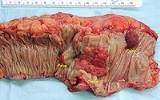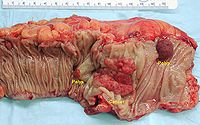
Colorectal polyp
Encyclopedia




Polyp (medicine)
A polyp is an abnormal growth of tissue projecting from a mucous membrane. If it is attached to the surface by a narrow elongated stalk, it is said to be pedunculated. If no stalk is present, it is said to be sessile. Polyps are commonly found in the colon, stomach, nose, sinus, urinary bladder...
(fleshy growth) occurring on the lining of the colon
Colon (anatomy)
The colon is the last part of the digestive system in most vertebrates; it extracts water and salt from solid wastes before they are eliminated from the body, and is the site in which flora-aided fermentation of unabsorbed material occurs. Unlike the small intestine, the colon does not play a...
or rectum
Rectum
The rectum is the final straight portion of the large intestine in some mammals, and the gut in others, terminating in the anus. The human rectum is about 12 cm long...
. Untreated colorectal polyps can develop into colorectal cancer
Colorectal cancer
Colorectal cancer, commonly known as bowel cancer, is a cancer caused by uncontrolled cell growth , in the colon, rectum, or vermiform appendix. Colorectal cancer is clinically distinct from anal cancer, which affects the anus....
.
Colorectal polyps are often classified by their behaviour (i.e. benign vs. malignant) and/or etiology (e.g. as a consequence of inflammatory bowel disease
Inflammatory bowel disease
In medicine, inflammatory bowel disease is a group of inflammatory conditions of the colon and small intestine. The major types of IBD are Crohn's disease and ulcerative colitis.-Classification:...
).
They may be benign (e.g. hyperplastic polyp), pre-malignant (e.g. tubular adenoma) or malignant (e.g. colorectal adenocarcinoma).
Types
The most common general classification is:- hyperplastic,
- neoplastic (adenomatous & malignant),
- hamartomatous and,
- inflammatory.
Hyperplastic polyp
Most hyperplastic polyps are found in the distal colonColon (anatomy)
The colon is the last part of the digestive system in most vertebrates; it extracts water and salt from solid wastes before they are eliminated from the body, and is the site in which flora-aided fermentation of unabsorbed material occurs. Unlike the small intestine, the colon does not play a...
and rectum
Rectum
The rectum is the final straight portion of the large intestine in some mammals, and the gut in others, terminating in the anus. The human rectum is about 12 cm long...
. They have no malignant potential , which means that they are no more likely than normal tissue to eventually become a cancer.
Hyperplastic polyps are serrated polyps. Hyperplastic polyps have three histologic
Histology
Histology is the study of the microscopic anatomy of cells and tissues of plants and animals. It is performed by examining cells and tissues commonly by sectioning and staining; followed by examination under a light microscope or electron microscope...
patterns of growth: microvesicular, goblet cell and mucin poor.
Hyperplastic polyposis syndrome is a rare condition that has been defined by the World Health Organization
World Health Organization
The World Health Organization is a specialized agency of the United Nations that acts as a coordinating authority on international public health. Established on 7 April 1948, with headquarters in Geneva, Switzerland, the agency inherited the mandate and resources of its predecessor, the Health...
as either:
-
- Five or more hyperplastic polyps proximal to the sigmoid colonSigmoid colonThe sigmoid colon is the part of the large intestine that is closest to the rectum and anus. It forms a loop that averages about 40 cm...
, with two polyps greater than 10mm in diameter; or - Any number of hyperplastic polyps proximal to the sigmoid colon in a person with a first degree relative who has hyperplastic polyposis syndrome; or
- More than 30 hyperplastic polyps of any size throughout the colon and rectum.
- Five or more hyperplastic polyps proximal to the sigmoid colon
Neoplastic polyp
A neoplasm is a tissue whose cells have lost its normal differentiationCellular differentiation
In developmental biology, cellular differentiation is the process by which a less specialized cell becomes a more specialized cell type. Differentiation occurs numerous times during the development of a multicellular organism as the organism changes from a simple zygote to a complex system of...
. They can be either benign growths or malignant growths. The malignant growths can either have primary or secondary causes.
Adenomas
Neoplastic polyps of the bowel are often benign hence called adenomas. An adenoma is tumor glandular tissue, that has not (yet) gained the properties of a cancer.The common adenomas of the colon are the tubular, tubulovillous
Tubulovillous adenoma
Tubulovillous adenoma, TVA, is a type of polyp that grows in the colon and other places in the gastrointestinal tract and sometimes in other parts of the body. These adenomas may become malignant ....
, villous
Villous adenoma
Villous adenoma is a type of polyp that grows in the colon and other places in the gastrointestinal tract and sometimes in other parts of the body. These adenomas may become malignant . Villous adenomas have been demonstrated to contain malignant portions in about one third of affected persons,...
, and sessile serrated
Sessile serrated adenoma
In gastroenterology, a sessile serrated adenoma , also known as sessile serrated polyp , is a premalignant flat lesions of the colon, predominantly seen in the cecum and ascending colon....
(SSA).
As is evident from their name, sessile serrated and traditional serrated adenomas (TSAs) have a serrated appearance and can be difficult to distinguish microscopically from hyperplastic polyps. Making this distinction is important, however, since SSAs and TSAs have the potential to become cancers, while hyperplastic polyps do not.
The villous subdivision are associated with the highest malignant potential because they generally have the largest surface area. (This is because the villi are projections into the lumen and hence have a bigger surface area.) However, villous adenomas are no more likely than tubular or tubulovillous adenomas to become canerous if their sizes are all the same.
Hamartomatous polyp
They are growths, like tumours found in organs as a result of faulty development. They are normally made up of a mixture of tissues. They grow at the normal rate of the host tissue and rarely cause problems such as compression. A common example of a hamartomatous lesion is a strawberry naevus. Hamartomatous polyps are often found by chance; occurring in syndromes such as Peutz-Jegher Syndrome or Juvenile Polyposis Syndrome.Peutz-Jeghers syndrome
Peutz-Jeghers syndrome
Peutz–Jeghers syndrome, also known as hereditary intestinal polyposis syndrome, is an autosomal dominant genetic disease characterized by the development of benign hamartomatous polyps in the gastrointestinal tract and hyperpigmented macules on the lips and oral mucosa...
is associated with polyps of the GI tract and also increased pigmentation around the lips, genitalia, buccal mucosa feet and hands. People are often diagnosed with Peutz-Jegher after presenting at around the age of 9 with an intussusception. The polyps themselves carry little malignant potential but because of potential coexisting adenomas there is a 15% chance of colonic malignancy.
Juvenile polyps are hamartomatous polyps which often become evident before twenty years of age, but can also be seen in adults. They are usually solitary polyps found in the rectum
Rectum
The rectum is the final straight portion of the large intestine in some mammals, and the gut in others, terminating in the anus. The human rectum is about 12 cm long...
which most commonly present with rectal bleeding. Juvenile polyposis syndrome
Juvenile polyposis syndrome
Juvenile polyposis syndrome is a syndrome characterized by the appearance of multiple polyps in the gastrointestinal tract, usually in a child, adolescent or young adult. Polyps refers to a growth arising from the lumen of the colon or stomach...
is characterised by the presence of more than five polyps in the colon or rectum, or numerous juvenile polyps throughout the gastrointestinal tract
Gastrointestinal tract
The human gastrointestinal tract refers to the stomach and intestine, and sometimes to all the structures from the mouth to the anus. ....
, or any number of juvenile polyps in any person with a family history of juvenile polyposis. People with juvenile polyposis have an increased risk of colon cancer.
Inflammatory polyp
These are polyps which are associated with inflammatory conditions such as Ulcerative ColitisUlcerative colitis
Ulcerative colitis is a form of inflammatory bowel disease . Ulcerative colitis is a form of colitis, a disease of the colon , that includes characteristic ulcers, or open sores. The main symptom of active disease is usually constant diarrhea mixed with blood, of gradual onset...
and Crohns disease.
Symptoms
Colorectal polyps are not usually associated with symptoms. When they occur, symptoms include rectal bleedingFecal occult blood
Fecal occult blood refers to blood in the feces that is not visibly apparent. A fecal occult blood test checks for hidden blood in the stool...
, bloody stools
Blood in stool
In medicine, when referring to human feces, blood in stool can refer to multiple conditions:* Melena, with more blackish appearance, originating in upper parts of the gastrointestinal tract...
, abdominal pain
Abdominal pain
Abdominal pain can be one of the symptoms associated with transient disorders or serious disease. Making a definitive diagnosis of the cause of abdominal pain can be difficult, because many diseases can result in this symptom. Abdominal pain is a common problem...
and fatigue. A change in bowel habits may occur including constipation
Constipation
Constipation refers to bowel movements that are infrequent or hard to pass. Constipation is a common cause of painful defecation...
and diarrhoea. Occasionally, if a polyp is big enough to cause a bowel obstruction
Bowel obstruction
Bowel obstruction is a mechanical or functional obstruction of the intestines, preventing the normal transit of the products of digestion. It can occur at any level distal to the duodenum of the small intestine and is a medical emergency...
, there may be nausea
Nausea
Nausea , is a sensation of unease and discomfort in the upper stomach with an involuntary urge to vomit. It often, but not always, precedes vomiting...
, vomiting and severe constipation.
Screening and diagnosis
Colorectal polyps can be detected using a faecal occult blood test, flexible sigmoidoscopySigmoidoscopy
Sigmoidoscopy From Greek Sigma - eidos - scopy, to look inside an s-like object, is the minimally invasive medical examination of the large intestine from the rectum through the last part of the colon. There are two types of sigmoidoscopy, flexible sigmoidoscopy, which uses a flexible endoscope,...
, colonoscopy
Colonoscopy
Colonoscopy is the endoscopic examination of the large bowel and the distal part of the small bowel with a CCD camera or a fiber optic camera on a flexible tube passed through the anus. It may provide a visual diagnosis and grants the opportunity for biopsy or removal of suspected...
, virtual colonoscopy
Virtual colonoscopy
Virtual colonoscopy is a medical imaging procedure which uses x-rays and computers to produce two- and three-dimensional images of the colon from the lowest part, the rectum, all the way to the lower end of the small intestine and display them on a screen...
, digital rectal examination, barium enema
Barium enema
A lower gastrointestinal series, also called a barium enema, is a medical procedure used to examine and diagnose problems with the human colon . X-ray pictures are taken while barium sulfate fills the colon via the rectum.-Procedure:...
or a pill camera.
When does a polyp become a problem?
Malignant potential is associated with- degree of dysplasiaDysplasiaDysplasia , is a term used in pathology to refer to an abnormality of development. This generally consists of an expansion of immature cells, with a corresponding decrease in the number and location of mature cells. Dysplasia is often indicative of an early neoplastic process...
- Type of polyp (e.g. villous adenomaVillous adenomaVillous adenoma is a type of polyp that grows in the colon and other places in the gastrointestinal tract and sometimes in other parts of the body. These adenomas may become malignant . Villous adenomas have been demonstrated to contain malignant portions in about one third of affected persons,...
):- Tubular Adenoma: 5% risk of cancer
- Tubulovillous adenoma: 20% risk of cancer
- Villous adenoma: 40% risk of cancer
- Size of polyp:
- <1 cm =<1% risk of cancer
- 1 cm=10%risk of cancer
- 2 cm=15%risk of cancer
Normally an adenoma which is greater than 0.5 cm is treated
Treatment
Polyps can be removed during a colonoscopy or sigmoidoscopy using a wire loop that cuts the stalk of the polyp and cauterises it to prevent bleeding. Many "defiant" polyps — large, flat, and otherwise laterally spreading adenomas — may be removed endoscopically by a technique called endoscopic mucosal resection (EMR), which involves injection of fluid underneath the lesion to lift it and thus enable facilitate surgical excision. These techniques may be employed as an alternative to a much-more-invasive colectomyColectomy
Colectomy consists of the surgical resection of any extent of the large intestine .-History:Sir William Arbuthnot-Lane was one of the early proponents of the usefulness of total colectomies, although his overuse of the procedure called the wisdom of the surgery into question.-Indications:Some of...
.
Structure
Polyps are either pedunculated (attached to the intestinal wall by a stalk) or sessile (grow directly from the wall).External links
- "How I Do It" — Removing large or sessile colonic polyps. Dr. Brian Saunders MD FRCP; St. Mark’s Academic Institute; Harrow, Middlesex, UK. Retrieved April 9, 2008.
- http://www.netdoctor.co.uk/diseases/facts/colonpolyps.htm
- http://www.clevelandclinic.org/registries/inherited/jp.htm

